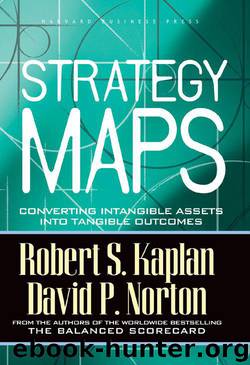Strategy Maps: Converting Intangible Assets into Tangible Outcomes by Robert S. Kaplan & David P. Norton

Author:Robert S. Kaplan & David P. Norton [Kaplan, Robert S.]
Language: eng
Format: mobi, azw3
Publisher: Harvard Business Review Press
Published: 2003-12-15T14:00:00+00:00
MEASURE INTANGIBLE ASSETS
At first glance, it seems daunting to measure assets—employee capabilities and alignment, information technology, and organizational climate and culture—that are defined by their intangibility, but some measurement principles seem clear. Intangible assets should not be measured by how much money was spent to develop them, nor should their value be determined by independent appraisals of the capabilities and value of HR and IT assets. The value of intangible assets comes from how well they align to the strategic priorities of the enterprise, not by how much it costs to create them or how much they are worth on a freestanding basis. If the intangible assets are closely aligned to the strategy, they will have greater value to the organization. The converse is also true; intangible assets that are not aligned to the strategy will not create much value, even if large amounts of money have been spent on them.
For measuring intangible assets, perhaps we can learn from the principles used in a company’s balance sheet to measure the organization’s tangible and financial assets. Accountants organize the asset side of the balance sheet by categories, such as cash, accounts receivable, inventory, property, plant, and equipment, and long-term investments. Assets are ordered hierarchically, by their degree of liquidity, the ease with which the asset can be converted to cash (see Figure 7-6). Accounts receivable is more liquid (quicker conversion to cash) than inventory, and both accounts receivable and inventory are classified as short-term assets since they typically convert to cash within twelve months. Long-term assets, as their name suggests, take longer to return the amount invested in them back to cash. For example, property, plant, and equipment (PP&E) provide a capability for converting raw materials to finished goods inventory, which gets sold, becomes accounts receivable and, eventually, cash. But many cycles of such conversion are required before the initial investment in PP&E is recovered.
Figure 7-6 Framework for Measuring Intangible Assets
Download
Strategy Maps: Converting Intangible Assets into Tangible Outcomes by Robert S. Kaplan & David P. Norton.azw3
This site does not store any files on its server. We only index and link to content provided by other sites. Please contact the content providers to delete copyright contents if any and email us, we'll remove relevant links or contents immediately.
Rich Dad Poor Dad by Robert T. Kiyosaki(6175)
Pioneering Portfolio Management by David F. Swensen(6079)
How To Win Friends and Influence People by Dale Carnegie(4332)
The Money Culture by Michael Lewis(3847)
The Dhandho Investor by Mohnish Pabrai(3560)
The Wisdom of Finance by Mihir Desai(3523)
Liar's Poker by Michael Lewis(3222)
The Intelligent Investor by Benjamin Graham Jason Zweig(2930)
The ONE Thing by Gary Keller(2918)
Mastering Bitcoin: Programming the Open Blockchain by Andreas M. Antonopoulos(2891)
Fooled by Randomness: The Hidden Role of Chance in Life and in the Markets by Nassim Nicholas Taleb(2860)
Rich Dad Poor Dad: What The Rich Teach Their Kids About Money - That The Poor And Middle Class Do Not! by Robert T. Kiyosaki(2834)
Investing For Dummies by Eric Tyson(2795)
How to Win Friends and Influence People by Dale Carnegie(2793)
How to Day Trade for a Living: Tools, Tactics, Money Management, Discipline and Trading Psychology by Andrew Aziz(2785)
Market Wizards by Jack D. Schwager(2539)
Zero Hour by Harry S. Dent Jr. & Andrew Pancholi(2533)
How to Pay Zero Taxes, 2018 by Jeff A. Schnepper(2500)
Rich Dad's Guide to Investing by Robert T. Kiyosaki(2411)
